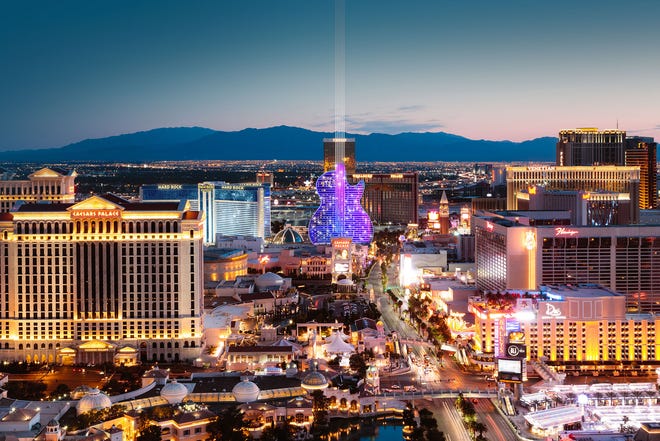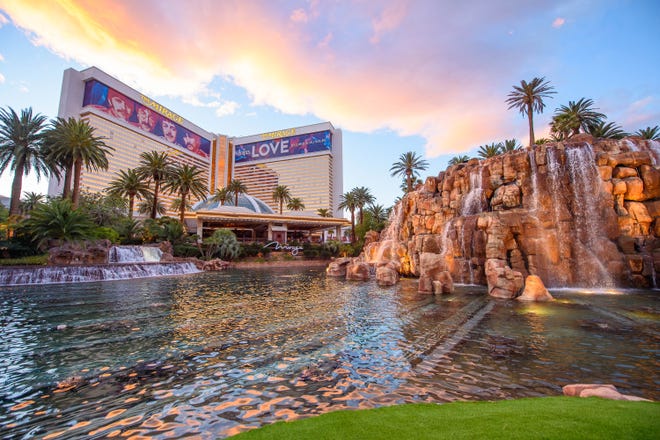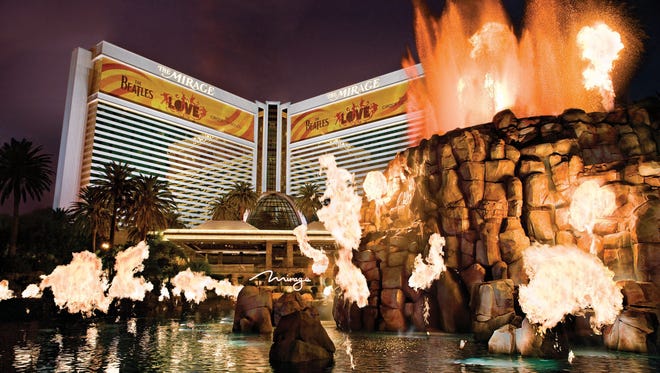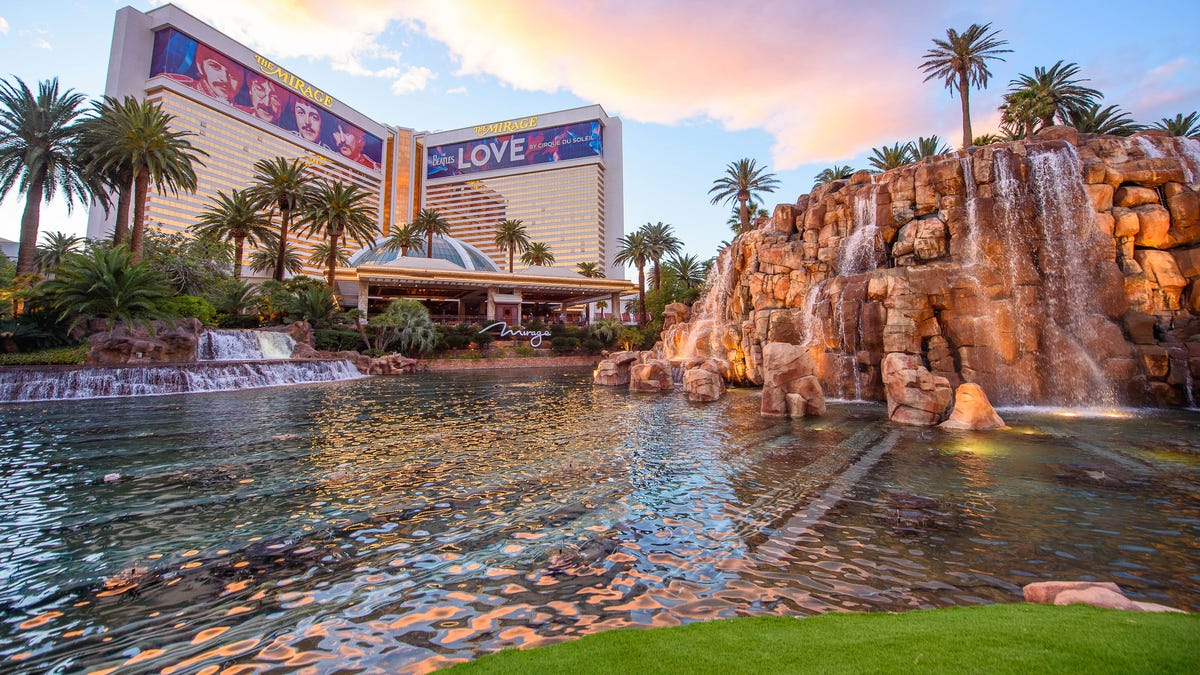MGM Resorts International has agreed to sell the Las Vegas Strip’s first megaresort, the Mirage, to Hard Rock International for nearly $1.1 billion in cash.
Hard Rock International is set to acquire the operations of the Mirage, subject to regulatory approvals and other customary closing conditions, according to a Monday news release. Hard Rock said it plans to build a guitar-shaped hotel on the Las Vegas Strip.
“As part of the team that opened The Mirage in 1989, I know firsthand how special it is, and what a great opportunity it presents to the Hard Rock team,” said MGM Resorts CEO and President Bill Hornbuckle in a media release. “I want to thank all of our Mirage employees who have consistently delivered world-class gaming and entertainment experiences to our guests for more than three decades.”

This isn’t the first time the Hard Rock brand has found a home in Las Vegas.
A Hard Rock Hotel had previously been operating just east of the Strip, but was sold by Brookfield Asset Management in 2018 to billionaire Richard Branson’s Virgin Hotels and partners, including investment firm Juniper Capital Partners. After undergoing expansive renovations, the property reopened as Virgin Hotels Las Vegas earlier this year.
Hard Rock International has hinted at expanding its portfolio to the Strip, and last year purchased the rights to the Hard Rock’s brand and related trademarks in Las Vegas from Juniper Capital Partners.
“We look forward to the opportunity of enhancing our presence in Las Vegas, which will always be one of the most iconic entertainment markets in the world,” Chairman Jim Allen said in a May 2020 statement.
Allen said Monday that Hard Rock International – which is owned by The Seminole Tribe of Florida – plans to welcome the property’s 3,500 employees to its team, and will enter a long-term lease agreement with real estate investment trust VICI Properties Inc.
“When complete, Hard Rock Las Vegas will be a fully integrated resort welcoming meetings, groups, tourists and casino guests from around the world to its nearly 80 acre center-Strip location,” Allen said.
►Las Vegas vacation:10 fun things to do when traveling by yourself to Las Vegas
►Come explore with us:Subscribe to our Travel newsletter
The sale is expected to close in the second half of next year and comes 32 years after the Mirage’s opening on Nov. 22, 1989. USA TODAY spoke with Las Vegas historians and casino industry experts, who say the property forever changed the Las Vegas Strip by ushering in a new age ofhigh-end resorts financed by Wall Street.
“It really did start the modern era of casino resorts in Las Vegas on the Strip,” said David Schwartz, an affiliate professor in the University of Nevada, Las Vegas department of history.
A new vision for the Las Vegas Strip
When the Mirage first opened its doors, Las Vegas was still known as a value destination with affordable rooms, giveaway entertainment and 99-cent shrimp cocktails.
The cheap amenities worked on certain crowds, but not all were impressed – including Alan Feldman, a former executive at MGM Resorts and distinguished fellow in responsible gaming for UNLV’s International Gaming Institute.
“I found it pretty cheap and tacky,” said Feldman, who grew up in nearby Los Angeles in the late ‘70s and early 80s. “When my parents said, ‘Oh, we’re going to Las Vegas for the weekend,’ I did not find that terribly appealing.”

While Las Vegas’ deals and casinos had been enough to draw in visitors for decades, its tried-and-true attractions were beginning to falter in the face of new competition. More states began opening up lotteries in the ’70s, New Jersey citizens approved gambling in Atlantic City in 1976 and American Indian casinos began to take off in the late ’80s after a Supreme Court ruling confirmed that tribes have the right to conduct gaming activities in certain states.
Suddenly, Americans could scratch their gambling itch without making a trip to the desert.
After years of growth, visitation rates began to slip in the early ’80s. That posed a problem for Las Vegas Strip properties, which brought in nearly 60% of their revenue from casinos in that period.
“In that era, Las Vegas was doing all right. But it was not setting the world on fire,” Michael Green, an associate professor of history at UNLV, told USA TODAY.
Then came Steve Wynn’s Mirage, ready to reignite the world with its simulated volcano.

The property was the largest resort in the world when it first opened its doors, with more than 3,000 roomsspread across 29 stories. It was also the most expensive hotel in its time, with a price tag that surpassed $600 million.
“A lot of (other resorts) had pointed the way toward size and scale,” Feldman said. “The Mirage certainly did that too, but it ushered in a whole generation of quality that a lot of folks didn’t realize Las Vegas was capable of delivering or didn’t even think, necessarily, that the audience for Las Vegas cared about.”
Ushering in a new era
The Mirage opened with plenty of non-gaming attractions, including performances by illusionists Sigfried and Roy and a tropical atrium. The Siegfried & Roy’s Secret Garden and Dolphin Habitat was added in 1990.
Experts agree that the megaresort would be an inspiration to Las Vegas Strip properties for years to come. Just look at the Y-shape hotel towers at Treasure Island or Park MGM, or outdoor attractions like the Bellagio’s fountains. Then there’s the focus on non-gaming revenue it helped spearhead; these days, more than 60% of Strip resort revenues come from outside the casinos.
“(The Mirage) set a template,” Green said. “The theme, the elegance, the special attractions … while the Mirage was not unique in having any of these ideas, it was unique at the time in putting them all together. And from there, it isn’t a long step to a yellow brick road or a pyramid or canals.”
The financing behind the project was also innovative. Casino mogul Wynn turned to “junk-bond king” Michael Milken to help fund the project.
Many thought it would go bankrupt. But the Mirage was an instant success, with about 50,000 guests showing up the first night. Las Vegas visitation rates exploded the year after its opening, spiking almost 15% to nearly 21 million visitors in 1990. By 1993, the property was filling 98% of its rooms on an average night.
Felman said the property and its financing were “absolutely defining” for Las Vegas.
“Up to that point, Las Vegas was relying on … I’m going to call it secondary and tertiary financing, which is a very polite way of referring to mob money,” he said. “All of a sudden, you had banks falling all over themselves trying to get Las Vegas developers money.”
Without that shift, it’s hard to imagine later properties like the $4.3 billion Resorts World Las Vegas.
“Things have changed a lot since (the Mirage) opened,” Schwartz said. “Rooms, for example, have tended to get bigger. But it really set a standard when it opened and has a lot of potential today.”
Why did MGM Resorts sell the Mirage?
So why sell such an iconic property?
Experts say it may have to do with location. The Mirage is an outlier among MGM Resorts’ portfolio, surrounded by competitors on the north end of the Strip while its sister properties lie in the central and southern segments.
MGM Resorts – which has focused on pivoting toward an “asset-light” business model in recent years – has already sold off two other northern Strip properties, Circus Circus in late 2019 and Treasure Island in 2009, while announcing in September plans to purchase the operations of The Cosmopolitan of Las Vegas, located further south.
The Mirage sale “is a fantastic outcome for (MGM Resorts), as we are able to re-prioritize future capital expenditures toward opportunities that will enhance the customer experience at our other locations in Las Vegas,” said CFO and Treasurer Jonathan Halkyard in a news release.
The Mirage was also one of the last MGM Resorts properties to welcome guests back after COVID-related shutdowns. The property reopened in August 2020, followed only by Park MGM in September.
“As we look at capital allocation, and we look at the notion of diversification, we have enough of Las Vegas,” MGM Resorts CEO Bill Hornbuckle said of the Mirage during a November earnings call. “We think there is an opportune time and we think this might be it to sell asset an in Las Vegas. And so (the Mirage) became for us the obvious one.”
Follow USA TODAY reporter Bailey Schulz on Twitter: @bailey_schulz.
